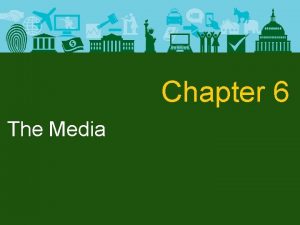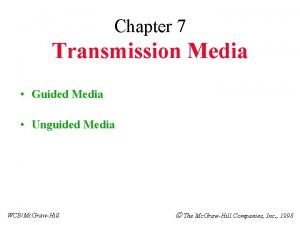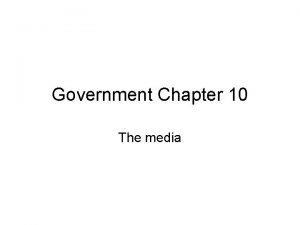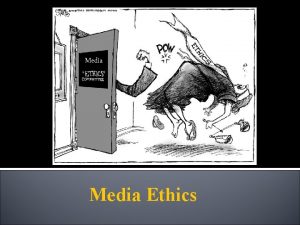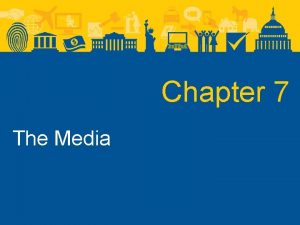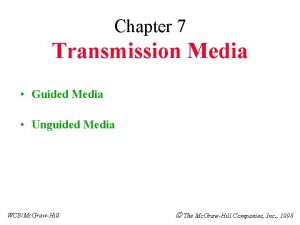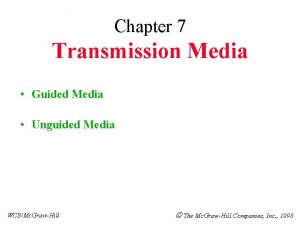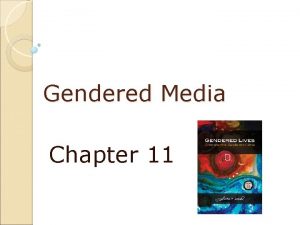The Media Chapter 9 CHAPTER 9 THE MEDIA














- Slides: 14

The Media Chapter 9 CHAPTER 9: THE MEDIA

In this chapter you will: • • Learn how media coverage of politics is changing Consider the democratic promises and pitfalls of mainstream and social media Explore how the media is (and is not) biased Understand the rules that channel the media into its current forms Discover how U. S. media is distinctive Assess how media coverage influences politics, campaigns, and elections CHAPTER 9: THE MEDIA

Media and American Democracy • A vast change is underway in media formats, driven by rapid technological advancement. • Media outlets continue to perform essential democratic functions: providing information, acting as “watchdogs” to protect the public trust, shaping what news is reported (agenda setting), setting the context for a topic (priming), and describing it in specific ways (framing). CHAPTER 9: THE MEDIA

U. S. Media Today Traditional Formats Are Declining • Thirty years ago, a few outlets—three networks, a weekly news magazine, and the local newspaper— delivered roughly the same news. Today, media outlets cater to every perspective—left, right, and center. Americans no longer share a single source of news. • Previous waves of rising “new” media—newspapers, radio, and television—changed the nature of news reporting and altered political institutions such as the presidency. CHAPTER 9: THE MEDIA

U. S. Media Today Traditional Formats Are Declining • Today all these now-traditional institutions are in serious decline. Newspapers, newsmagazines and network and local television are all losing ground as the place Americans go for news. Internet sources, especially social media platforms, are taking their place —especially among young people. • The new media raises several major concerns, including: Do the benefits—everyone’s ability to contribute to “news” and increased transparency—outweigh losing traditional reporting sources and rising incidence of “fake news”? Will these more democratic formats find large audiences, or are we too fragmented into individual niches? And can new media invent revenue sources that enable them to cover vital but sometimes obscured stories, especially about local issues? CHAPTER 9: THE MEDIA

Is the Media Biased? • Both conservatives and liberals complain of media bias. However, the media generally reflects the politics of its audience—which is to the left of conservatives and to the right of liberals. • The media’s deepest bias comes from its need to win ratings and appeal to advertisers. That puts an emphasis on drama, scandal, and conflict— exacerbating partisan political divisions. • Media efforts to be objective and balanced can introduce their own biases, such as “fairness. ” CHAPTER 9: THE MEDIA

How Governments Shape the Media • Democratic nations organize their media in three ways: government ownership, regulation, and markets. The United States has historically relied on the latter two models, regulation and markets. • The First Amendment protects print media from most government regulation. CHAPTER 9: THE MEDIA

How Governments Shape the Media • Broadcast media in the United States was originally regulated by agencies such as the FCC, which imposed the fairness doctrine—a reflection of a less partisan era. The FCC is still active, but reduced its own power further by ending “net neutrality. ” • Deregulation, new technologies, and the rise of multiple media have created the spectrum of perspectives and views that mark American media today. At the same time, a handful of giant media companies now control much of the content we see and hear. This contributes to our partisan and conflicted politics. CHAPTER 9: THE MEDIA

Media Around the World • Rapidly changing media outlets link citizens to their politics around the world. An open media is a vital key to making democracy work. • The American model of media as private enterprise is spreading. However, most other democracies retain more government regulation than the United States. • Authoritarian nations censor their news reporters. Increasingly, new media forms are challenging government control of the news, but the censors are keeping pace. CHAPTER 9: THE MEDIA

Understanding the Media in Context War, Terrorism, and U. S. Elections • Reporting on war and terrorism has long attracted more viewers than almost any other political story. Ethical questions about the nature of media coverage continue to reshape editors’ approach to these dramatic stories. • Media coverage of campaigns reflects the general patterns of the contemporary media. It emphasizes drama, conflict, and the horse race narrative. • Campaigns attempt either to influence the media or to bypass it and speak directly to supporters. These efforts in turn become part of the media coverage. CHAPTER 9: THE MEDIA

Chapter Summary • The media—and the stories editors and users choose to emphasize—helps set the political agenda, prime the electorate, and frame issues. • Media stories affect public opinion—primarily among people who do not have strong opinions. Because these people tend to pay less attention to the news, stories with clear signals (heavy coverage, a strong perspective) will change their views. • Media platforms have expanded from the traditional television, radio, and newspapers to include online news sites, podcasts, Facebook, Twitter, and more. CHAPTER 9: THE MEDIA

Chapter Summary • Media technology changes very rapidly, and each change reshapes the connection between citizens and their leaders—a crucial criterion for democracy. A big question runs through this chapter: Does today’s media strengthen American democracy or weaken it? • News sources are changing. Newspapers, magazines, television, and radio are all facing very different business models, and rushing to fill the void with new formats such as on-demand streaming and podcasts. Online news is rising fast. Today, it is the number one source of news for people under thirty. The enormous number of news sources spans the political spectrum and blurs the line between entertainment and news. CHAPTER 9: THE MEDIA

Chapter Summary • Yes, the media is biased. Reporters in the mainstream press are less conservative than the general population, but they do not seem to tilt election coverage. The deepest bias— across the entire news media spectrum—comes from the media’s purpose: It is a business that needs an audience to generate revenue. Therefore the news emphasizes drama, conflict, and scandal. • In most other democracies, the government ran the first radio and TV stations and still plays a large role in the media world, although commercial media is rising. In authoritarian countries, the new social media poses a threat to the old model of information control and press censorship. CHAPTER 9: THE MEDIA

Chapter Summary • • • The new social media is changing the nature of news and information. On the upside, users are more active. They can choose, respond, report, comment, critique, create, and share. Candidates and parties have new ways to connect. On the downside, the ready availability of news on the Internet has challenged the pay models of traditional print outlets, leading to a new media environment that facilitates the spread of rumors and even lies. All this means that we as a society do not share the same news. This influence gives it considerable power over American politics. Whether that power is used for the public benefit is a much-debated question—perhaps most sharply when it comes to covering urgent topics such as war, terrorism, and election campaigns. In many ways, the media reflects America. What we watch and hear tells us who we are. CHAPTER 9: THE MEDIA
 Hát kết hợp bộ gõ cơ thể
Hát kết hợp bộ gõ cơ thể Slidetodoc
Slidetodoc Bổ thể
Bổ thể Tỉ lệ cơ thể trẻ em
Tỉ lệ cơ thể trẻ em Gấu đi như thế nào
Gấu đi như thế nào Tư thế worm breton
Tư thế worm breton Chúa yêu trần thế alleluia
Chúa yêu trần thế alleluia Các môn thể thao bắt đầu bằng tiếng bóng
Các môn thể thao bắt đầu bằng tiếng bóng Thế nào là hệ số cao nhất
Thế nào là hệ số cao nhất Các châu lục và đại dương trên thế giới
Các châu lục và đại dương trên thế giới Cong thức tính động năng
Cong thức tính động năng Trời xanh đây là của chúng ta thể thơ
Trời xanh đây là của chúng ta thể thơ Mật thư anh em như thể tay chân
Mật thư anh em như thể tay chân Phép trừ bù
Phép trừ bù Phản ứng thế ankan
Phản ứng thế ankan


















